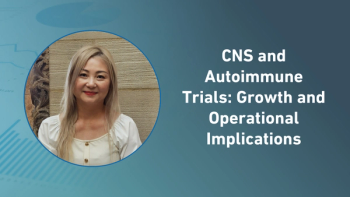
- Applied Clinical Trials-05-01-2021
- Volume 30
- Issue 5
Why Centralized Monitoring and RBQM are Here to Stay
How it has taken a global pandemic to reinforce the intrinsic benefits.
Over the last year, sponsors and CROs have embraced centralized monitoring and risk-based quality management (RBQM) in a bid to keep trials on track under extenuating pandemic circumstances. The shift may have been out of necessity initially, but the benefits–from accelerated development timelines to a higher likelihood of study success–have been obvious. Now, there is no putting the genie back in the bottle: RBQM and centralized monitoring are here to stay.
When the pandemic hit in early 2020, unnecessary face to face contacts, including clinic visits, were halted and regulatory bodies recommended fresh risk assessments for all ongoing studies. This shift framed the traditionally conservative sector in a new light. Suddenly, concepts such as remote and centralized monitoring along with the broader RBQM paradigm, which have long been lingering at the side lines of clinical trial management, were brought into sharp focus. As companies navigated the minefield of regulation and inherent risk, tailored assessment and decentralized data collection became essential. Meanwhile, their benefits, pandemic or no pandemic, became obvious.
RBQM, with its ability to quickly prove therapies are safe and effective, can dramatically accelerate the drug development pathway. It drives up data quality and allows early risk detection, both of which are crucial to supporting the pace of programs and making high efficacy treatments widely available in the shortest time possible.
As such, we are now seeing an industry-wide move towards this new way of working. In a recent poll taken from our webinars, out of 650 industry representatives, 56% said there were either already implementing RBQM or were about to start. A further 25% said it was already an integral part of how they run their trials. Overall, 81% are either implementing or have already fully adopted RBQM.
Meeting COVID-specific regulations,1,2 and addressing the huge additional risks the pandemic introduced to clinical trials was a daunting task. Yet, organizations were unfazed and worked quickly to develop the tools and processes they needed to ensure their studies could continue safely and effectively.
One CRO, a global leader in early phase clinical research services, for example, applied CluePoints’ complimentary COVID-19 package, which incorporated a SARS-CoV-2-specific Risk Assessment template, to more than 100 studies. They used the tool, which features relevant risk categories, associated considerations, and detailed Key Risk Indicators (KRIs), to define COVID risk and establish mitigation procedures. For them, and many other organizations like them, going through this process has demonstrated the value of proactive risk mitigation in protecting data integrity and maximizing the chances of trial success.
RBQM in vaccine trials
RBQM solutions provide a way of identifying, visualizing, managing, and documenting the risks that could impact the outcome of a clinical trial. The method has proved its worth during the pandemic, especially in the race to find a vaccine, where at least one sponsor organization utilized the approach to support the rapid development of their product.
Centralized risk monitoring software allowed the sponsor to interrogate data from more than 100 global sites in near-real time. Using a combination of KRIs, quality tolerance limits, and statistical data monitoring techniques, a central monitoring team was able to conduct twice-weekly risk review meetings with the study team. This allowed potential issues to be identified, investigated, and rectified before they even had a chance to affect data quality.
By focusing on speed, accuracy, and reliability, the sponsor was able to mitigate risk to both patient safety and data integrity. In doing so, they were able to lessen any potential delays to final approval submission at a crucial point in the global health crisis.
Across the sector, every effort is being made to achieve unprecedented progress with vaccine trials and COVID-19 treatments. Several leading CROs have selected RBQM solutions to ensure that no data quality stone is left unturned in this mission. Such platforms allow clinical trials to detect risks as early as possible, meaning corrective action can be taken in record time–and this is a benefit that far transcends the pandemic.
Developers and sponsors around the world are united in their aim to get life-changing new medicines to the people who need them as quickly as possible. And, as demonstrated above, RBQM helps organizations to do just that. In addition, robust RBQM solutions allow teams to access information centrally, collaborate on investigations, and document any mitigations or remedial actions. Not only does this result in a clean dataset, but it also creates a reliable audit trial for regulatory scrutiny.
Traditional site monitoring methods, such as source data verification (SDV), are quite simply unable to provide the same level assurance within such rigorous processes and rapid timelines.
Centralized monitoring
Centralized monitoring is another pertinent area in the field of clinical trial management. Cloud-based centralized monitoring solutions allow sponsors to interrogate clinical and operational data in real-time, increasing efficiency, improving patient safety and reducing costs.3
Since early 2020, on-site monitoring has not, in the main part, been possible, and central statistical monitoring has presented a proven alternative. Statistical algorithms that interrogate study data accurately and in an unsupervised manner help to identify risks early. This allows stakeholders to focus their attention on atypical sites, patients, regions
or countries.
It has proved extremely useful during the pandemic, but this approach, which regulators have long advocated, seems set to stay in a world where remote working has gone from a “nice-to-have” to imperative for business continuity. Fortunately, it is possible to eliminate or reduce on-site monitoring without significantly impacting trial oversight. Sponsors and CROs utilize a centralized monitoring platform that triggers site follow-up by web-based applications, phone, or email if risks are detected.
Key learnings
Last year was an opportunity to reflect on what matters most–and it is vital not to lose sight of what we can achieve when we work collaboratively. By seizing the moment, we can continue to aspire to even greater achievements.
It has been an extremely challenging time for clinical trial management, but it has also demonstrated the benefits of early risk identification. As such, COVID-19 accelerating the implementation of RBQM solutions. The approach allows study leaders to use the risk assessment process to first identify and then focus on the most critical data–the safety and endpoint data that matters most to each individual trial. It has proven invaluable in effectively managing studies to database lock with all the necessary assurances.
Clearly, the inability to physically visit sites has tremendously impacted onsite monitoring, and sponsors have increased their reliance on techniques such as centralized monitoring. In this respect, COVID-19 has accelerated a movement that has been simmering since the 2016 release of ICH E6 (R2) and has helped to drive change away from inefficient, legacy practices.
Organizations are now committing to adopting these data-driven approaches as their permanent operating practices in the future. Astellas, for example, has said it has no plans to revert to SDV transcription checking, which the company has said does not provide the same value as risk-based management.4
Looking to the future
The pandemic has demonstrated the value of modern clinical trial management, meaning it will undoubtedly ensure that the long-promised shift to risk-based methodologies will finally become reality.
Sponsors know that if they are to have any chance of seeing an increase in drug development pipeline activity, they must do more with less. Virtual trials, remote monitoring, wearables, and RBQM are all attractive ways of doing just that, but, up until now, adoption has been slow.
The pandemic has provided the catalyst the industry needed to take the risk-based bull by the horns. And in moving from theory to practice, it has proved the approach can accelerate development while protecting data integrity.
References
https://www.outsourcing-pharma.com/Article/2020/12/07/How-has-COVID-19-impacted-clinical-trial-data-collection https://www.ema.europa.eu/en/human-regulatory/overview/public-health-threats/coronavirus-disease-covid-19/guidance-medicine-developers-other-stakeholders-covid-19 https://globalforum.diaglobal.org/issue/september-2020/looking-to-the-future-with-rbqm/ https://www.centerwatch.com/articles/24898-remote-monitoring-wont-require-post-pandemic-re-monitoring-fda-says
Patrick Hughes, Chief Commercial Officer and Co-Founder, CluePoints
Articles in this issue
over 4 years ago
Rise of the Activated Patient During COVID—Biopharma on Noticeover 4 years ago
Aligning Medical Monitoring and Data Scienceover 4 years ago
Utilizing DHTs for Clinical Trial Endpointsover 4 years ago
Navigating New Changes During the Pandemicover 4 years ago
Maximizing the Value of Remote Monitoringover 4 years ago
Protecting Patients in COVID-19 Vaccine Clinical Trialsover 4 years ago
Clinical Trials Day Every May, or Every Day?over 4 years ago
Applied Clinical Trials May 2021 Issue (PDF)over 4 years ago
New Structures to Tackle New Challenges in European Healthcareover 4 years ago
Biden Seeks Added Funding for Medical Research, Disease TrackingNewsletter
Stay current in clinical research with Applied Clinical Trials, providing expert insights, regulatory updates, and practical strategies for successful clinical trial design and execution.






.png)



.png)



.png)
.png)
